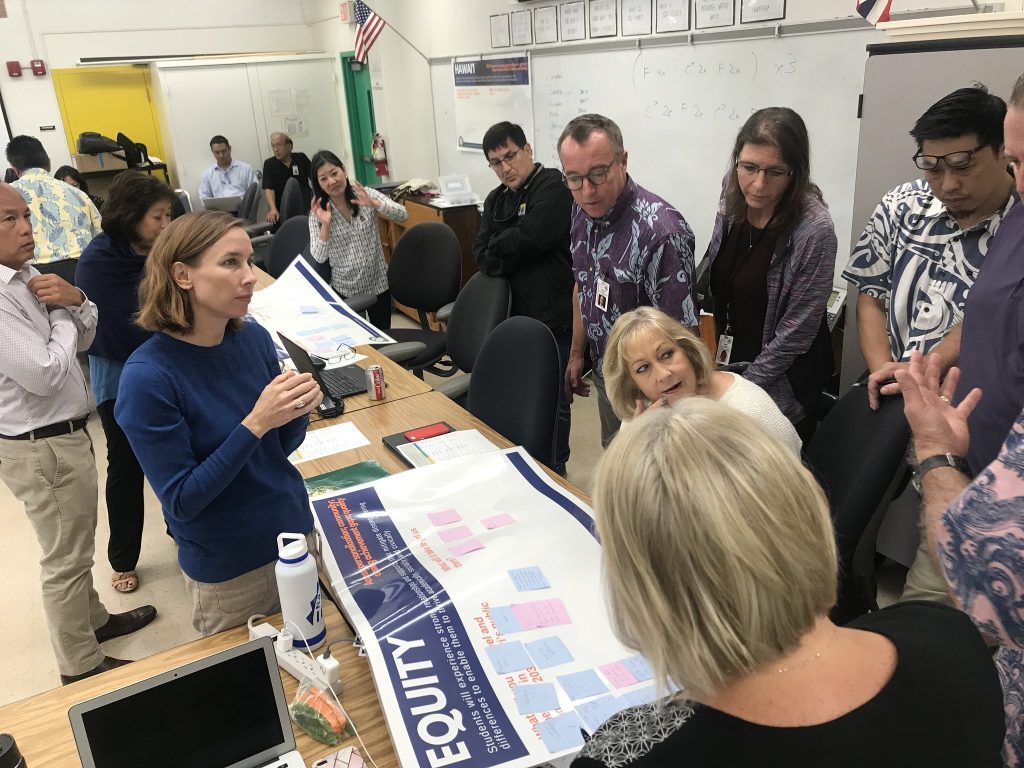Input Sought on Next Decade of Hawai‘i Education

Community invited to provide input on Hawai’i DOE’s next 10 years. PC: Hawai’i Department of Education feedback session
The Hawaiʻi State Department of Education is seeking feedback on the first draft of a 2030 Promise Plan, which will guide the department for the next 10 years, centered around five promises to students.
An online toolkit for the community to provide feedback is available at HawaiiPublicSchools.org. Feedback will be gathered through Aug. 1, with a first draft of the plan to be delivered in September. The availability of the toolkit was announced at the Board of Education’s General Business Meeting at the Nānākuli Public Library on Thursday.
“Our students are too important for small promises,” said Superintendent Dr. Christina M. Kishimoto. “Our next phase of strategic planning will bring together stakeholder vision and purpose around public education as a change agent for Hawai‘i, fueled by our three strategies: School Design, Teacher Collaboration and Student Voice.”
Through the five promises to students, HIDOE seeks to build and expand upon gains that have been made over the last two strategic plans and innovate to solve persistent challenges. The aim is a thriving, sustainable state that embodies the values of hā.
The promises are:
- Hawai‘i: Students will be educated within a public school system that is grounded in HĀ, powers a multilingual society, and honors Hawai‘i’s local and global contribution.
- Equity: Students will experience strong relationships and supports that mitigate disempowering differences to enable them to thrive academically, socially, and civically.
- School Design: Students will be immersed in excellent learning environments that are thoughtfully designed around a community’s power to contribute to a thriving, sustainable Hawai‘i.
- Empowerment: Students will develop their authentic voice as contributors to equity, excellence and innovation, by providing input on what they learn, how they learn, and where they learn.
- Innovation: Students will engage in rigorous, technology-rich, problem-solving learning that enables them to solve authentic community challenges and develop pathways to goals.
The feedback to be gathered from HIDOE staff and the community revolves around what these promises look like and what it will take to get there by 2030, focusing on creative solutions. Complex Area Superintendents will be working with their principals and Assistant Superintendents with their offices to collect their insight.
“We look forward to building equity, excellence, and innovation in every public school through the next strategic plan,” said Deputy Superintendent Phyllis Unebasami. “This is a great opportunity for the community to drive the conversation about their public school system.”
The online toolkit features a step-by-step guide to the process and supporting materials to help anyone in the community prepare, promote and host a feedback session.
“I’m proud to be from Nānākuli. I’m looking forward to using the plan to make good on our promises to this community,” said Nānākuli High & Intermediate Principal Darin Pilialoha. “We are expanding our learning capacity through partnerships and building our core values of self-appreciation and appreciation for this place.”
The conversation around the 2030 Promise Plan began in January 2019 when Supt. Kishimoto released her vision statement to encourage school communities and families to think about three guiding questions as we move into the next decade:
- What do we value in a PK-12 educational experience? Many will agree that what we value most in the school experience, which informs our understanding of student success, is not fully captured in an accountability system.
- How do we measure what we really value? We must take on the challenge of incorporating qualitative measures if we value students developing metacognition, empathy, and engaging in research and contributing to a knowledge base.
- How do we support each child to experience success? Learning structured around exploration, creativity, discovery and design is different from mandated content coverage and demonstration of isolated, discrete skills. More children are reached, engaged and supported by the former; it inspires lifelong learning.
After a first draft of the plan is released in September 2019, another round of feedback in reaction to the plan will be gathered, decisions will be made regarding aligned benchmarks and metrics, and a final plan will be presented to the Board of Education early next year.













